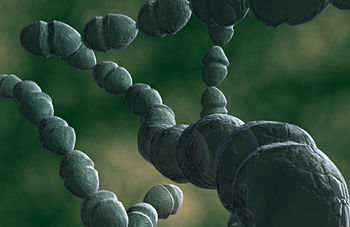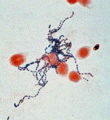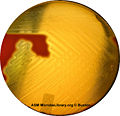Streptococcus pyogenes: Difference between revisions
imported>Lizbeth Nunez No edit summary |
imported>Lizbeth Nunez |
||
| Line 19: | Line 19: | ||
==Description and significance== | ==Description and significance== | ||
<gallery> | |||
Image:GramstainStreptococcuspyogenes.gif|Gram-positive ''Streptococcus pyogenes'' | |||
</gallery> | |||
''Streptococcus pyogenes'' is also known as Group A streptococci (GAS). It is a Gram-positive, nonmotile, non-sporeforming coccus <ref>http://www.textbookofbacteriology.net/streptococcus.html</ref]. They typically appear in purulent lesions or broth cultures as 0.5 to 1.0µm spherical or ovoid cells in chains of short to medium length (4 to 10 cells) <ref>Murray, Patrick R., Kobayashi, George S., Pfaller Michael A., Rosenthal, Ken S. Medical Microbiology. Second edition. Mosby-Year Book, Inc. St Louis, Missouri 1994.</ref>. | |||
<gallery> | |||
Image:Streptococcus pyogenes fig2 aplha hemolysis.jpg | |||
|Alpha hemolysis of GAS | |||
</gallery>Growth is optimal on enriched blood agar media but is inhibited if the medium contains a high concentration of glucose <ref>Murray, Patrick R., Kobayashi, George S., Pfaller Michael A., Rosenthal, Ken S. Medical Microbiology. Second edition. Mosby-Year Book, Inc. St Louis, Missouri 1994.</ref>. On blood agar plates colonies are usually compact, small and surrounded by a 2-3 mm zone of beta hemolysis (complete lysis of red cells surrounding the colony) that is easily seen and sharply demarcated. | |||
This type of reaction has long been used to classify the streptococci. Group A streptococci is a strict human pathogen, and no other known reservoir or species is affected by diseases unique to this organism <ref>J.J. Ferretti, W.M. McShan, D. Ajdic, D. J. Savic, G. Savic, K. Lyon, S. Sezate, A. N. Suvorov, C. Primeaux, S. Kenton, H. Lai, S. Lin, Y. Qian, H. Jia, H. Zhu, Q. Ren, F.Z, Najar, L. Song, J. White, X. Yuan, S. W. Clifton, B. A. Roe, R. McLaughlin. Complete Genome Sequence of an M1 Strain of Streptococcus pyogenes. PNAS USA. 98, 4658-4663. April 10, 2001.</ref> | |||
This pathogen is responsible for a vast number of human infections that range from uncomplicated conditions to clinically severe invasive diseases. Some of the diseases are: pharyngitis (most common), tonsillitis (commonly referred to as strep throat), sinusitis, otitis, pneumonia, impetigo, erysipelas, cellulitis, joint or bone infections, necrotizing fasciitis, myositis, meningitis, endocarditis, rheumatic fever and glomerulonephritis (the last two as post streptococcal sequelae) <ref>http://www.textbookofbacteriology.net/streptococcus.html</ref><ref>Murray, Patrick R., Kobayashi, George S., Pfaller Michael A., Rosenthal, Ken S. Medical Microbiology. Second edition. Mosby-Year Book, Inc. St Louis, Missouri 1994</ref>. All of these diseases are most common in settings of poverty. By 2005 it was estimated that there were at least 517 000 deaths each year due to severe GAS diseases. They estimated that there are at least 1.78 million new cases each year and a prevalence of at least 18.1 million cases. Most of which are rheumatic heart disease (at least 15.6 million cases). GAS is an important cause of morbidity and mortality <ref>J.R. Carapetis et al., The global burden of group A streptococcal disease, Lancet Infect. Dis. 5 (2005), pp. 685–694.</ref> | |||
==Genome structure== | ==Genome structure== | ||
Revision as of 20:53, 16 April 2008
Articles that lack this notice, including many Eduzendium ones, welcome your collaboration! |
| Streptococcus pyogenes | ||||||||||||||
|---|---|---|---|---|---|---|---|---|---|---|---|---|---|---|
| [[image:|200px|]] | ||||||||||||||
| Scientific classification | ||||||||||||||
| ||||||||||||||
| Binomial name | ||||||||||||||
| Streptococcus pyogenes |
Description and significance
Streptococcus pyogenes is also known as Group A streptococci (GAS). It is a Gram-positive, nonmotile, non-sporeforming coccus Cite error: Closing </ref> missing for <ref> tag.
Growth is optimal on enriched blood agar media but is inhibited if the medium contains a high concentration of glucose [1]. On blood agar plates colonies are usually compact, small and surrounded by a 2-3 mm zone of beta hemolysis (complete lysis of red cells surrounding the colony) that is easily seen and sharply demarcated.
This type of reaction has long been used to classify the streptococci. Group A streptococci is a strict human pathogen, and no other known reservoir or species is affected by diseases unique to this organism [2]
This pathogen is responsible for a vast number of human infections that range from uncomplicated conditions to clinically severe invasive diseases. Some of the diseases are: pharyngitis (most common), tonsillitis (commonly referred to as strep throat), sinusitis, otitis, pneumonia, impetigo, erysipelas, cellulitis, joint or bone infections, necrotizing fasciitis, myositis, meningitis, endocarditis, rheumatic fever and glomerulonephritis (the last two as post streptococcal sequelae) [3][4]. All of these diseases are most common in settings of poverty. By 2005 it was estimated that there were at least 517 000 deaths each year due to severe GAS diseases. They estimated that there are at least 1.78 million new cases each year and a prevalence of at least 18.1 million cases. Most of which are rheumatic heart disease (at least 15.6 million cases). GAS is an important cause of morbidity and mortality [5]
Genome structure
Describe the size and content of the genome. How many chromosomes? Circular or linear? Other interesting features? What is known about its sequence? Does it have any plasmids? Are they important to the organism's lifestyle?
Cell structure and metabolism
Describe any interesting features and/or cell structures; how it gains energy; what important molecules it produces.
Ecology
Describe any interactions with other organisms (included eukaryotes), contributions to the environment, effect on environment, etc.
Pathology
How does this organism cause disease? Human, animal, plant hosts? Virulence factors, as well as patient symptoms.
Application to Biotechnology
Does this organism produce any useful compounds or enzymes? What are they and how are they used?
Current Research
Enter summaries of the most recent research here--at least three required
References
- ↑ Murray, Patrick R., Kobayashi, George S., Pfaller Michael A., Rosenthal, Ken S. Medical Microbiology. Second edition. Mosby-Year Book, Inc. St Louis, Missouri 1994.
- ↑ J.J. Ferretti, W.M. McShan, D. Ajdic, D. J. Savic, G. Savic, K. Lyon, S. Sezate, A. N. Suvorov, C. Primeaux, S. Kenton, H. Lai, S. Lin, Y. Qian, H. Jia, H. Zhu, Q. Ren, F.Z, Najar, L. Song, J. White, X. Yuan, S. W. Clifton, B. A. Roe, R. McLaughlin. Complete Genome Sequence of an M1 Strain of Streptococcus pyogenes. PNAS USA. 98, 4658-4663. April 10, 2001.
- ↑ http://www.textbookofbacteriology.net/streptococcus.html
- ↑ Murray, Patrick R., Kobayashi, George S., Pfaller Michael A., Rosenthal, Ken S. Medical Microbiology. Second edition. Mosby-Year Book, Inc. St Louis, Missouri 1994
- ↑ J.R. Carapetis et al., The global burden of group A streptococcal disease, Lancet Infect. Dis. 5 (2005), pp. 685–694.


